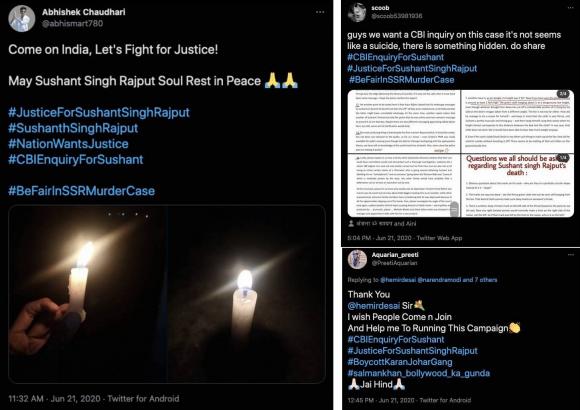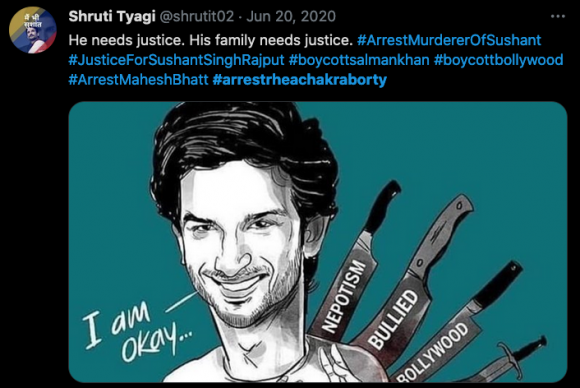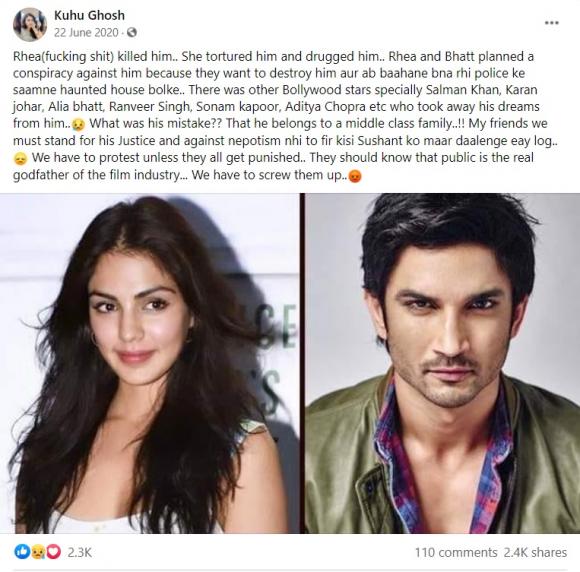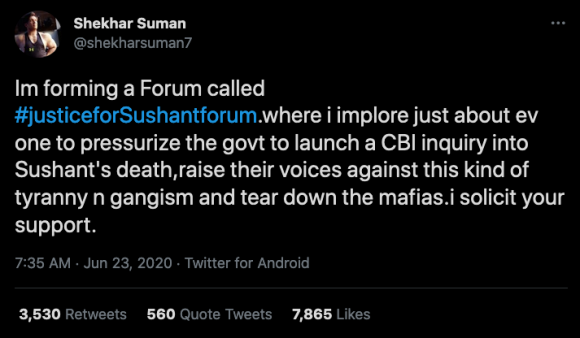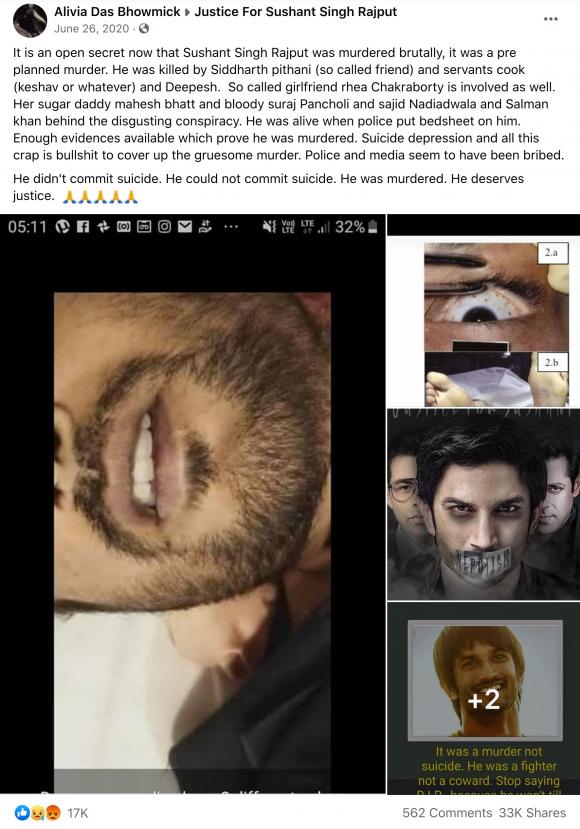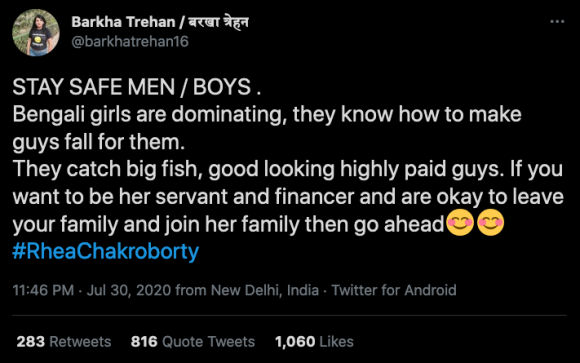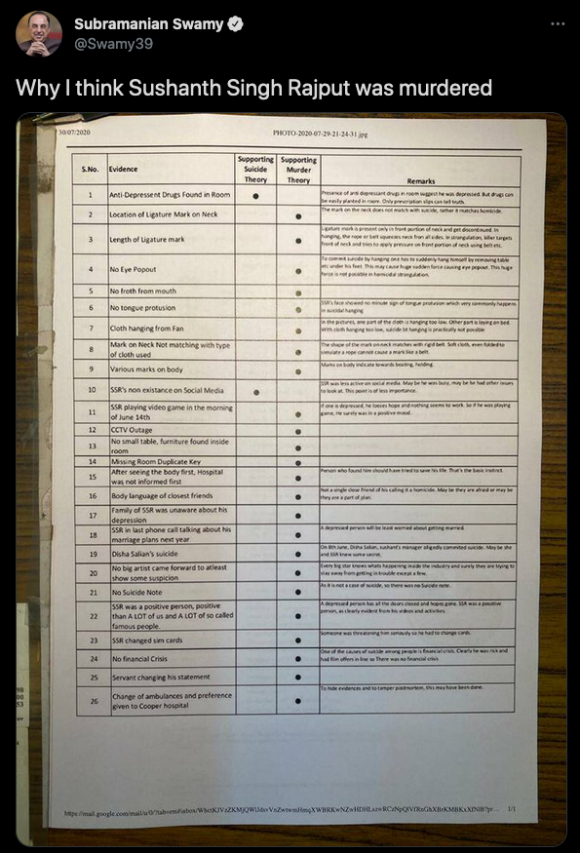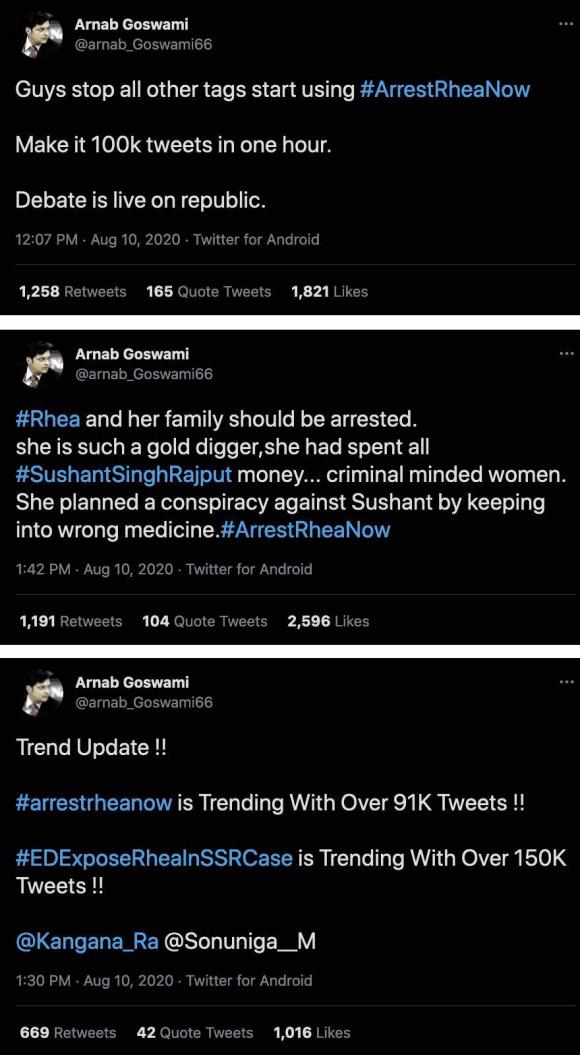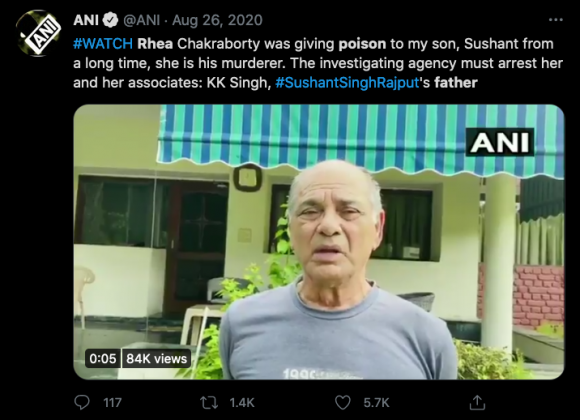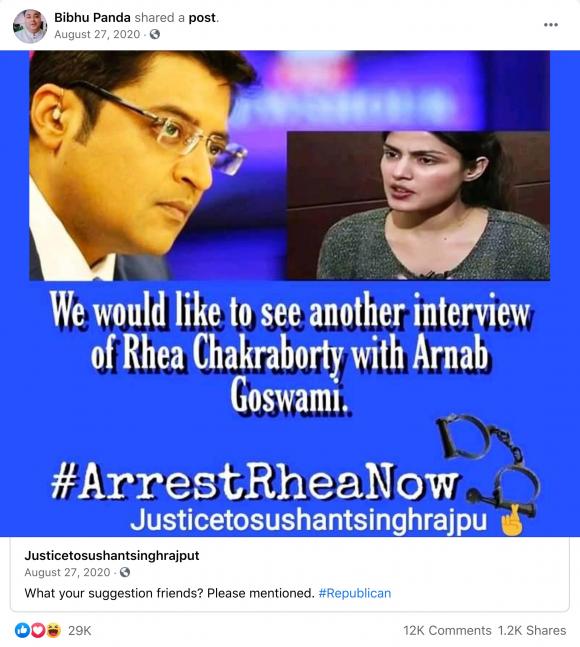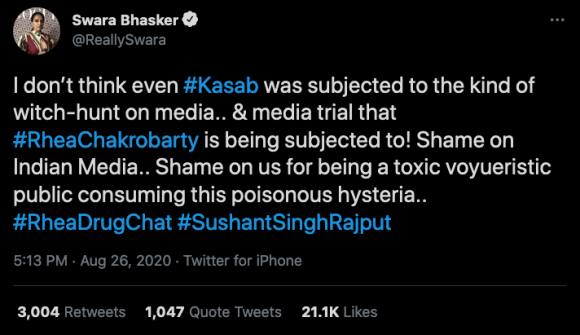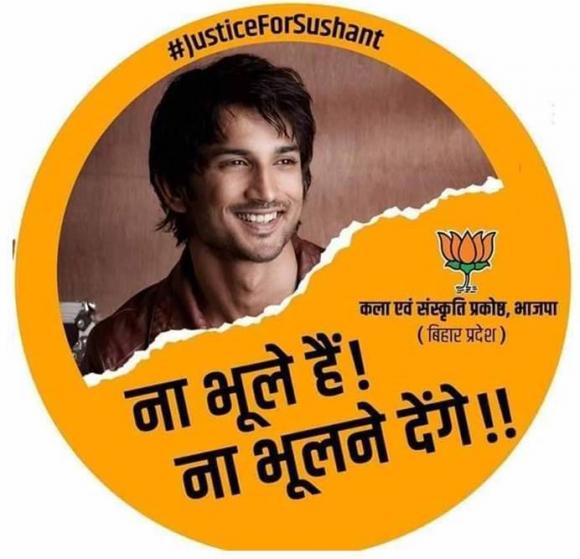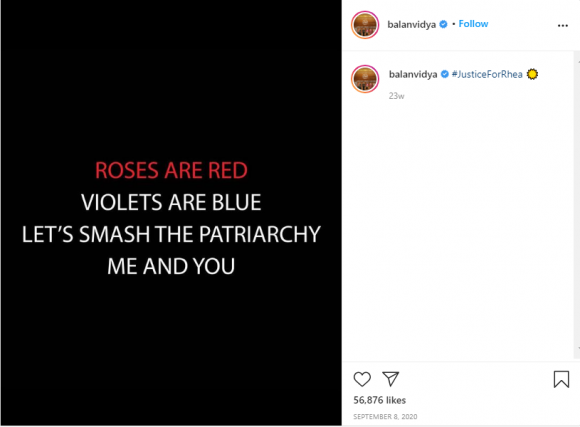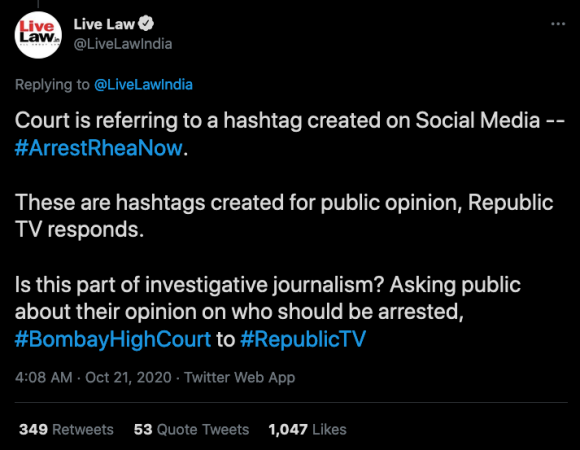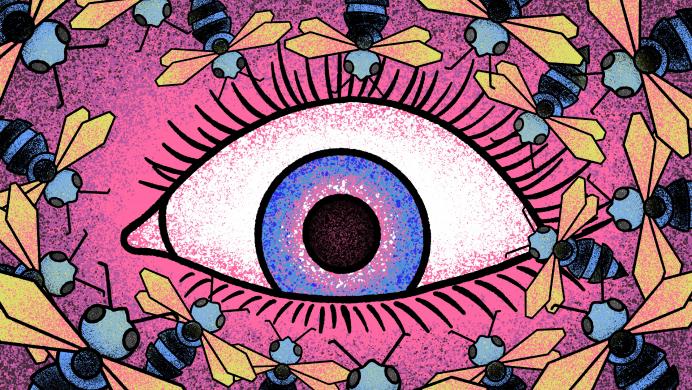

Targeted Harassment: The Media-Led Witch Hunt of Rhea Chakraborty
Overview
On June 14, 2020, Bollywood actor Sushant Singh Rajput was found dead in his apartment in Mumbai. According to Mumbai Police, evidence suggested that Rajput had a history of mental health concerns and had committed suicide. However, Rajput’s family members and fans began circulating on Facebook and Twitter the allegation that Rajput had been murdered. Politicians and influencers from the media amplified these rumors. Some Indian television media channels broadcast these false narratives, including the rumor that Rajput’s girlfriend at the time of his death, Rhea Chakraborty, had murdered him. This muddied the waters about the official investigations and initiated a trial by media against Chakraborty that resulted in her targeted harassment. Across social media and Indian TV, people demanded that national agencies investigate and arrest her. The targeted campaign worked. Chakraborty was arrested on September 8, 2020 by the Narcotics Control Bureau for drug-related allegations in connection to Rajput’s death. She was released on October 6 after the Bombay High Court granted her bail on grounds of insufficient evidence. While there are many facets to this ongoing series of events, this particular case study demonstrates how a breaking news event combined with prejudice, political adoption, and media exposure can lead to harassment and the spread of potentially harmful and misleading information.
STAGE 1: Manipulation Campaign Planning and Origins
On June 14, 2020, Sushant Singh Rajput, a 34-year old television and movie star from Bihar, India, was found dead in Mumbai, in the state of Maharashtra.1 Bollywood personalities, Indian political leaders, and fans expressed shock at the news of his death and offered condolences on social media. Prime Minister Narendra Modi tweeted, “Sushant Singh Rajput.. A bright young actor gone too soon..”
The Mumbai police initially concluded that Rajput had committed suicide, backed by postmortem reports that showed cause of death by asphyxia due to hanging.2 On June 15, the police stated that Rajput had been consulting a psychiatrist to treat depression.3 The same day, Rajput’s maternal uncle alleged that he had been murdered and that there was a conspiracy in connection to his death.4 Although official investigations by Mumbai police had begun, this led to swarms of fans who turned into partisan volunteer investigators and experts, dissecting facts around Rajput’s death, calling the absence of a suicide note “suspicious,”5 and linking other celebrities to the “crime,” most notably his girlfriend Rhea Chakraborty, a less-well-known actor. For example, on June 17, a post on suggested that Chakraborty’s close friendship with Bollywood director Mahesh Bhatt might somehow be linked to Rajput’s death.6
On June 18, Chakraborty was brought in for questioning by the Mumbai Police as a matter of normal investigative procedure. The accusations continued on social media calling her a liar (see figure 1 below for an example).
- 1Priya Arora, “Sushant Singh Rajput, Bollywood Star, Dies at 34,” The New York Times, June 14, 2020, https://www.nytimes.com/2020/06/14/world/asia/sushant-singh-rajput-death.html.
- 2 “Mumbai: Actor Sushant Singh Rajput dies by suicide,” Scroll.in, June 14, 2020, https://scroll.in/latest/964658/mumbai-actor-sushant-singh-rajput-dies-by-suicide-say-reports.
- 3“Sushant Singh Rajput showed signs of clinical depression, sought counselling: Police,” The Indian Express, June 16, 2020, https://indianexpress.com/article/cities/mumbai/sushant-singh-rajput-showed-signs-of-clinical-depression-sought-counselling-police-6460482/.
- 4“We don’t think he committed suicide, police must investigate, says Sushant Singh Rajput’s maternal uncle,” ANI News, June 15, 2020, https://www.aninews.in/news/national/general-news/we-dont-think-he-committed-suicide-police-must-investigate-says-sushant-singh-rajputs-maternal-uncle20200615093708/.
- 5Shekhar Suman (@shekharsuman7), "It's crystal clear,if presuming Sushant Singh committed suicide,the way he was,strong willed and intelligent, he would have definitely definitely left a suicide http://note.My heart tells me,like many others,there is more than meets the eye.," , June 23, 2020, https://twitter.com/shekharsuman7/status/1275302237472845825.
- 6Saswat Kar, “#We_want_justice”, Facebook, June 17, 2020, https://www.facebook.com/groups/1412729682205680/permalink/2186315768180397.
Disbelieving the police theory of suicide and focusing on his status as an outsider in the nepotistic Indian film industry, fans of Rajput started forming iterations of “Justice for Sushant” groups on Facebook and Twitter, and calling on the highest investigating body in India, the Central Bureau of Investigation (CBI), to take over the inquiry. Hashtags and viral slogans such as #justiceforSushanthSinghRajput, #Warriors4SSR, #JusticeforSSR, #CBIforSSR, #ArrestRhea emerged shortly after Rajput’s death was first reported. (See figure 2 below for an example.)
By June 22, there were more calls from Rajput’s fans to hold Chakraborty accountable, calling her a murderer and implicating other Bollywood personalities in a conspiracy to harm Rajput. (See figures 3a and 3b below.)
STAGE 2: Seeding Campaign Across Social Platforms and Web
Within days, Rajput’s death had turned into a social media spectacle, as politicians, Bollywood stars, and media personalities joined the call for “justice for Sushant.” It became a flash point in an ongoing cultural debate about the insurality of Bollywood and who was allowed to take part in its world, which had become a wedge issue that encompassed questions of race and caste. On June 19, Kangana Ranaut, a Bollywood actor who had previously spoken out against nepotism in the film industry, amplified the conspiracy narrative and posted a video on Twitter, questioning the cause of Rajput’s death and calling it an “emotional, psychological & mental lynching.”1 This was retweeted 43.7K times, with 155.5K likes and 2.8 million views.
On June 23, actor Shekhar Suman fueled the call for #JusticeforSushant by forming his own forum for the cause.2 He posted a tweet reiterating a fan’s demand for the CBI to take over the inquiry from Mumbai Police. (See figure 4 below.)
- 1 Kangana Ranaut (@KanganaTeam), "Emotional, psychological & mental lynching • On an happens openly and we all are all guilty of watching it silently. Is blaming the system enough? Will there ever be change? Are we going to see a monumental shift in the narrative on how outsiders are treated?," Twitter, June 19, 2020, https://twitter.com/KanganaTeam/status/1273939226371911685.
- 2Shekhar Suman (@shekharsuman7), "Im forming a Forum called #justiceforSushantforum.where i implore just about ev one to pressurize the govt to launch a CBI inquiry into Sushant's death,raise their voices against this kind of tyranny n gangism and tear down the mafias.i solicit your support.," Twitter, June 23, 2020, https://twitter.com/shekharsuman7/status/1275392077946216449.
Though Chakraborty, like Rajput, had also entered the film industry as an outsider with no known nepotistic connections, she was accused of conspiring with other Bollywood big-wigs to murder Rajput.1 An example of one of the posts common during this time can be seen below in figure 5.
- 1Nigar KD (@KdNigar), "Im forming a Forum called #justiceforSushantforum.where i implore just about ev one to pressurize the govt to launch a CBI inquiry into Sushant's death,raise their voices against this kind of tyranny n gangism and tear down the mafias.i solicit your support.," Twitter, June 24, 2020, https://twitter.com/KdNigar/status/1275711054220312577.
Eventually on July 25, a First Information Report (FIR) was filed against Chakraborty and her family members in Bihar, Rajput’s home state, on the bequest of his father.1 An FIR is an official police document that sets a criminal proceeding in motion. The case was booked for charges of abetment of suicide, criminal breach of trust, theft, wrongful confinement, and wrongful constraint. Rajput’s sister, Mitu Singh, allegedly told the police that Chakraborty performed black magic on her brother. Accusing Chakraborty of being a witch, who is from the state of West Bengal where women have been already stereotyped as manipulative seductresses and practitioners of black magic, also led to trolling of Benagli women in general (see figure 6a).2 Around the same time, fans of Rajput started Chakraborty with new epithets, calling her #rheagolddigger, #GoldDiggerRheaChakraborty, and accusing her of stealing from Rajput (see figure 6b).
- 1“Sushant Singh Rajput’s Father Lodges FIR Against Actor Rhea Chakraborty, 6 Others,” The Wire, July 28, 2020, https://thewire.in/government/sushant-singh-rajputs-father-fir-rhea-chakraborty.
- 2Debaline Dey, “If your Bengali girlfriend knew ‘black magic’, she would erase misogyny, not waste it on you,” The Print, August 2, 2020, https://theprint.in/opinion/pov/if-your-bengali-girlfriend-knew-black-magic-she-would-erase-misogyny-not-waste-it-on-you/473079/.
On July 27, Mumbai police announced that forensic evidence proved foul play was not a factor in Rajput’s death. This did not deter the growing demand for the case to be transferred to the CBI and the continued networked of Chakraborty.1
- 1“Viscera report rules out foul play in Sushant Singh Rajput’s death: Official,” The Indian Express, July 27, 2020, https://indianexpress.com/article/entertainment/bollywood/viscera-report-rules-out-foul-play-in-sushant-singh-rajput-death-6526296/.
STAGE 3: Responses by Industry, Activists, Politicians, and Journalists
An outcome of this campaign was that it muddied the waters in creating confusion around the cause of Rajput’s death. It led to a social media frenzy, amplified by Bollywood actors, politicians, social media and celebrity influencers, and television news channels. For example, on July 29, Subramaniam Swamy, a politician belonging to the ruling Bharatiya Janta Party (BJP) tweeted that evidence in Rajput’s death pointed to murder and not suicide (figure 7 below).1
- 1Subramanian Swamy (@Swamy39), “Why I think Sushanth Singh Rajput was murdered,” Twitter, July 29, 2020, https://twitter.com/Swamy39/status/1288645048830222339.
Public outrage over Rajput’s death resulted in criminal investigations by three different Central agencies, who all filed FIRs against Chakraborty and her family members: the Enforcement Directorate (ED), the Central Bureau of Investigation (CBI) and the Narcotics Control Bureau.1 In response to the FIR registered in Bihar, Chakraboty filed a petition in the Supreme Court to restore jurisdiction over the case to the Mumbai Police, also informing the court that she faced death and rape threats online.2 Meanwhile, following up on the charges filed against Chakraborty by Rajput’s father, on July 31 the Enforcement Directorate filed a money laundering case in connection with the death. The same day, Chakraborty appeared in a video acknowledging the online abuse she has faced and expressing faith in the judiciary to exonerate her.3
Television news channels had been closely following the case since the day of Rajpit’s death, and speculating about the probable cause of Rajput’s death with their followers on social media. They called Chakraborty “manipulative” and said she “performed black magic” and “drove Sushant to suicide.”4 She continued to be trolled on social media, where people called her a “fortune huntress,” a “mafia moll” and “sex bait to trap rich men.”5 For example, on July 30, Aaj Tak, a Hinidi television news channel accused Chakraborty of doing “kaala jaadu” (black magic) on Rajput, for which it was slammed by several Twitter users for unethical and insensitive journalism.6 The same channel also hosted discussions on whether Chakraborty had been a bad girlfriend.7
On August 7, Chakraborty and her family members were questioned for hours by the Enforcement Directorate in Mumbai over the money laundering accusations.8 By August 10, Republic TV, a news channel led by founder and news anchor Arnab Gowsami, amplified the call for Chakraborty’s arrest, and called her a “gold digger” and “criminal-minded women [sic].” In figure 8 below you can see Gowsami’s attempt at gaming an algorithm by appealing to his followers to get #ArrestRheaNow to trend on Twitter.
- 1Alok Deshpande, Sonam Saigal, and Devesh Kumar Pandey, “Sushant Singh Rajput: Life and death in the spotlight,” The Hindu, September 5, 2020, Alok Deshpande, Sonam Saigal, and Devesh Kumar Pandey, “Sushant Singh Rajput: Life and death in the spotlight,” The Hindu, September 5, 2020, https://www.thehindu.com/news/national/sushant-singh-rajput-life-and-death-in-the-spotlight/article32526228.ece..
- 2Sanjay Sharma, “Rhea Chakraborty in petition to Supreme Court: Sushant Singh Rajput and I were in live-in, he was in depression,” India Today, July 30, 2020, https://www.indiatoday.in/movies/celebrities/story/rhea-chakraborty-in-petition-to-supreme-court-sushant-singh-rajput-and-i-were-in-live-in-he-was-in-depression-1706153-2020-07-30.
- 3NDTV, Rhea Chakraborty On Allegations in Sushant Singh Case: “Truth Shall Prevail”, , July 31, 2020, https://www.youtube.com/watch?v=cOwB8coAg9Q.
- 4Geeta Pandey, “Sushant Singh Rajput: Rhea Chakraborty on ‘media trial’ after Bollywood star’s death”, BBC News, August 27, 2020, https://www.bbc.com/news/world-asia-india-53932725.
- 5Ibid.
- 6Meenu Katariya, “Illogical & Insensitive: Twitter Slams News Channel’s Report Showing Rhea’s ‘Black Magic’ On Sushant,” ScoopWhoop, July 31, 2020, https://www.scoopwhoop.com/news/twitter-aaj-tak-news-channel-report-showing-rhea-black-magic-on-sushant/.
- 7Kairvy Grewal and Taran Deol, “Aaj Tak debates if Rhea was a bad girlfriend, Zee Newa’ WhatsApp ‘update’ for justice,” The Print, August 31, 2020, https://theprint.in/plugged-in/aaj-tak-debates-is-rhea-a-bad-girlfriend-zees-sachin-arora-whatsapp-update-for-justice/492345/.
- 8Sadaf Modak and Khushboo Narayan, “Rhea Chakraborty, her father and brother questioned by ED,” The Indian Express, August 8, 2020, https://indianexpress.com/article/india/rhea-chakraborty-her-father-and-brother-questioned-by-ed-6545023/.
On August 13, as the Supreme Court of India considered whether to allow CBI to take over the case, one of Rajput’s sisters took to Twitter and appealed to Prime Minister Narendra Modi and Home Minister Amit Shah. “We stand together as a nation for CBI Enquiry!,” Shweta Singh Rajput tweeted.1 At time of writing, her tweet was retweeted 34.4K times and received 2.5 million views. On August 19, the Supreme Court of India transferred the case to CBI and ordered Mumbai Police to hand over all evidence.2
In addition to the case that was registered against Chakraborty and her family for abetment of suicide, Rajput’s family also started accusing her of “poisoning” him and a drug-related investigation was launched against her based on WhatsApp chats retrieved from her phone.3 On August 26, Asian News International (ANI) shared a video on Twitter of Rajput’s father calling Chakraborty a murderer and asking for her immediate arrest (figure 9a below). On the same day, following the drug allegations, the Narcotics Control Bureau registered a case against Chakraborty for “possessing, purchasing and using cannabis,” and “abetment and criminal conspiracy to commit an offence.”4 With this, Chakraborty and her family were being investigated by three different national agencies in connection to Rajput’s muder.
- 1Shweta Singh Kirti (@shwetasinghkirt), "We stand together as a nation for CBI Enquiry! Demanding an unbiased investigation is our right and we expect nothing but the truth to come out. 🙏 #CBIForSSR #Warriors4SSR #justiceforSushanthSinghRajput @PMOIndia @narendramodi @AmitShah," Twitter, August 13, 2020, https://twitter.com/shwetasinghkirt/status/1293759413413539842.
- 2Nayear Azad, “Sushant Singh Rajput case: Supreme Court verdict evokes political reactions in Bihar,” Deccan Chronicle, August 19, 2020, https://www.deccanchronicle.com/nation/current-affairs/190820/sushant-singh-rajput-case-supreme-court-verdict-evokes-political-reac.html.
- 3Arvind Gunasekar and Saurabh Gupta, “Rhea Chakraborty “His Murderer”: Sushant Rajput’s Father Amid Drug Probe: 10 Points,” NDTV, August 27, 2020, https://www.ndtv.com/india-news/rhea-chakraborty-his-murderer-sushant-rajputs-father-amid-drug-probe-2285985?browserpush=true.
- 4Ibid.
Meanwhile, some fans and celebrities came out in support of Chakraborty, referring to her harassment as misogynistic abuse and a “media trial.” They appropriate the use of hashtags for justice by calling for #JusticeforRhea (figure 10 below).
With elections in Bihar, Rajput’s home state, around the corner, seeking justice for his death had also become a political scheme. For example, on September 6, the Bharatiya Janta Party released posters for #JusticeForSushant with their party logo, making it an electoral issue and showing the campaign has reached .1 According to an independent study that analysed Twitter data between June 14 and September 12, 2020, there were 103,125 tweets related to Sushant Singh Rajput from 7,818 Indian politicians, with members and supporters of the Bharatiya Janta Party (BJP) taking the lead to seed theories of murder.2
- 1Santosh Singh, “Ahead of polls, Bihar BJP’s culture wing releases posters seeking ‘justice for Sushant Singh Rajput,” The Indian Express, September 6, 2020, https://indianexpress.com/article/india/sushant-singh-rajput-bihar-bjp-posters-6585247/.
- 2Syeda Zainab Akbar, Ankur Sharma, Himani Negi, Anmol Panda, Joyojeet Pal, ‘Anatomy of a Rumour: Social media and the suicide of Sushant Singh Rajput,’ October 8, 2020, arXiv:2009.11744v2 [cs.SI].
On September 7, Kriti Singh Rajput amplified calls for fans of Rajput worldwide to put up billboards and flyers, and asked people to form peaceful rallies to make it into a “People’s Movement.”1 Fans of Rajput also made videos demanding a proper investigation into his death and calling on people across the globe to “stand together.”2
After questioning Chakraborty for three consecutive days, the Narcotics Bureau arrested her on September 8, along with nine others, on charges of buying cannabis for Rajput.3 Her arrest amplified the of her involvement in Sushant’s death, splitting social media users and celebrities into #JusticeforSushant and #JusticeforRhea campaigns. Some, such as Kirti Singh Rajput, Shekhar Suman and Rajput’s former partner, Ankita Lokhande, welcomed her arrest.4 Several other Bollywood personalities, such as Taapsee Pannu, Vidya Balan, and Anurag Kashyap, came out in support of her with calls to “smash the patriarchy.” (See figure 12 below.)5
- 1Shweta Singh Kirti (@shwetasinghkirt), "Put up Billboards and flyers in front of your home, on your car. Split into groups and have peaceful car rallies and tag me. Let’s make it into People’s Movement! We will not stop till the justice is served! #UnitedForSSRJustice #Billboards4SSR #SatyagrahForSSR #GlobalPrayers4SSR," Twitter, September 7, 2020, https://twitter.com/shwetasinghkirt/status/1303060855949459456 .
- 2Shweta Singh Kirti (@shwetasinghkirt), "We might be divided by borders, but we stay untied in emotions!! We want Justice for Sushant and nothing can distract us from our goal! #Warriors4SSR #DividedByBordersUnitedByEmotions #GlobalPrayers4SSR #JusticeForSSR," Twitter, September 1, 2020, https://twitter.com/shwetasinghkirt/status/1300809478753804288.
- 3“Sushant death case: Rhea Chakraborty arrested by Narcotics Bureau, sent to 14-day custody; model’s lawyer calls it ‘travesty of justice,’” The Economic Times, September 9, 2020, https://economictimes.indiatimes.com/magazines/panache/sushant-death-rhea-chakraborty-arrested-by-the-narcotics-control-bureau/articleshow/77995234.cms.
- 4“Taapsee Pannu to Shekhar Suman - Bollywood divided over Rhea Chakraborty’s arrest by the Narcotics Control Bureau,” Times of India, September 8, 2020, https://timesofindia.indiatimes.com/entertainment/hindi/bollywood/news/taapsee-pannu-to-shekhar-suman-bollywood-divided-over-rhea-chakrabortys-arrest-by-the-narcotics-control-bureau/articleshow/78000228.cms.
- 5“Rhea Chakraborty’s ‘Smash Patriarchy’ Message Resonates With Several in Bollywood,” The Wire, September 9, 2020, https://thewire.in/rights/rhea-chakraborty-arrest-smash-patriarchy-bollywood.
STAGE 4: efforts
Over the course of the investigations and media frenzy over Rajput’s death, several scholars and public intellectuals called out the manipulation by politicians to use Rajput’s death as a ploy to distract media and the public from mismanagement of the pandemic, arrests of human rights activists, and the slumping economy. Politicians were attempting to use Rajput, they argued, as a poster boy for the elections in the state of Bihar. In August, the Press Council of India, a statutory body established by Parliament, asked media organizations to adhere to journalistic standards and ethics and refrain from sensational reporting and trial by media.1 In September, an actor who was linked to the drug investigation in which Chakraborty was the primary target filed a petition to the Delhi High Court asking the media to exercise restraint in reporting on the case.2 Bombay High Court made similar observations while hearing petitions that challenged the media trial in Rajput’s death.3 Among the many civil society responses, the Network of Women in Media, India, denounced the media trial of Chakraborty.4 Several other Bollywood filmmakers and producers, after being implicated in Rajput’s death on social media and by journalists, filed another lawsuit in Delhi High Court on October 12 for “irresponsible reporting by certain media houses.”5 Several media outlets also spelled out the misogynistic campaign that sought to vilify women based on the long-standing prejudiced narrative of “bhola ladka-chaloo ladki (simple boy, manipulative girl),” a misogynistic cultural trope.6
The reporting on Rajput’s death also spurred a separate set of investigations into TV news channels gaming television ratings by producing sensational news and spreading fake narratives for ad revenues.7 Republic TV and its founder and anchor Arnab Gowsawmi, along with other media houses and journalists, have come under sharp scrutiny and critical press for leading a “witch hunt” against Chakraborty and assuming the role of “judge, jury and executioner” to manipulate public opinion.8 In parallel, several news and independent organizations also regularly fact-checked misinformation circulated on social media.9
- 1“Sushant Singh Rajput death: Media must not conduct parallel trial in case, says Press Council,” Scroll.in, August 28, 2020, https://scroll.in/latest/971660/sushant-singh-rajput-death-media-must-not-conduct-parallel-trial-in-case-says-press-council.
- 2“Media should exercise restraint, reputations getting tarnished: Delhi HC on actor Rakul Preet’s plea”, Scroll.in, September 17, 2020, https://scroll.in/latest/973337/media-should-exercise-restraint-reputations-getting-tarnished-delhi-hc-on-actor-rakul-preets-plea.
- 3“Sushanth Singh coverage: Surprised there is no government regulation of TV media, says Bombay HC,” Scroll.in, September 11, 2020, https://scroll.in/latest/972818/sushant-singh-coverage-surprised-there-is-no-government-regulation-of-tv-media-says-bombay-hc.
- 4“NWMI denounces TV news coverage of the Sushant Singh Rajput case,” NWMI, September 21, 2020, https://www.nwmindia.org/statements/portrayal-of-women-in-the-media/nwmi-denounces-tv-news-coverage-of-the-sushant-singh-rajput-case-2/.
- 5“‘Irresponsible reporting’: Top Bollywood production houses move court against Republic TV, Times Now,” Scroll.in, October 12, 2020, https://scroll.in/latest/975610/sushant-singh-rajput-case-top-bollywood-production-houses-move-court-against-republic-tv-times-now.
- 6N.C. Asthana, “The ‘Danse Macabre’ Around Rhea Chakraborty Has Exposed Indian Society’s Inherent Misogyny,” The Wire, September 10, 2020, https://thewire.in/society/rhea-chakraborty-sushant-singh-rajput-danse-macabre-indian-society-inherent-misogyny.
- 7Saurabh Gupta and Sreenivasan Jain, “Republic TV Among 3 Channels Busted for Rigging Ratings: Mumbai Cops,” NDTV, October 9, 2020, https://www.ndtv.com/india-news/republic-tv-among-3-channels-being-probed-for-trp-manipulation-mumbai-police-2307106.
- 8“Arnab Gowswami, Republic TV reported ‘distorted, misleading facts’ in Sushant Singh Rajput case, alleges PIL in Delhi HC,” Firstpost, October 09, 2020, https://www.firstpost.com/india/arnab-goswami-republic-tv-reported-distorted-misleading-facts-in-sushant-singh-rajput-case-alleges-pil-in-delhi-hc-8897281.html.
- 9 For example: “Fact Check: Are Nigerians Protesting To Seek Justice For Actor Sushant Singh Rajput,” The Logical Indian, October 17, 2020, https://thelogicalindian.com/fact-check/sushant-singh-rajput-nigeria-24376.
Following the explosion on social media about Rajput’s death and the emerging conspiracies, in October research and investigations by Mumbai Cyber Cell revealed that 80,000 fake accounts were created on social media platforms on June 14, 2020, the day of his death, to discredit official investigations.1 At least 19 hashtags were investigated by a team of cyber and forensic experts.2 They found over 150,000 suspicious Twitter accounts involved in the #JusticeForSushant campaigns, including over 1,000 bots operating in places like China, Panama, Hong Kong, and Nepal.3 Neither Twitter, nor other social media platforms like or Facebook, appear to have removed these suspicious accounts or content.
In October, while investigations by the CBI, ED, and NCB continued, the All India Institute of Medical Sciences in charge of re-evaluating the initial postmortem report confirmed that Rajput’s death was a case of suicide and not murder.4 Chakraborty was granted bail by the Bombay High Court on October 6 after spending 28 days in Mumbai’s Byculla prison on grounds of insufficient evidence of her participation in “an active member of a drug syndicate.”5
While investigations are still on-going in the case, with courts still probing Chakraborty’s involvement in Rajput’s death on separate petitions filed by aggrieved parties, the media amplified witch-hunt of Chakraborty and dissection of Rajput’s death has set a new precedent on news coverage in cases of suicide. Ruling on a public interest litigation (PIL) filed by Maharashtra police officers, activists, lawyers, and NGOs, on January 18, 2021, the Bombay High Court said that a media trial during an on-going investigation is “contemptuous” and obstructs administration of justice.6 Making up for the absence of regulations on electronic media, which was left up to self-regulation, the court ordered that the Press Council of India’s guidelines on coverage of sensitive criminal matters will now apply to electronic media as well as print media.7
- 1Mrityunjay Bose, “Mumbai police to hunt social media maligning cops over Susahnt Singh Rajput case,” Deccan Herald, October 06, 2020, https://www.deccanherald.com/national/west/mumbai-police-to-hunt-down-social-media-trolls-maligning-cops-over-sushant-singh-rajput-case-897992.html.
- 2“Bots, Twitter accounts used to defame Uddhav government on Sushant Singh Rajput death: Mumbai cops,” The New Indian Express, November 4, 2020, https://www.newindianexpress.com/nation/2020/nov/04/bots-twitter-accountsused-to-defame-uddhav-government-onsushant-singh-rajput-deathmumbai-cops-2218943.html.
- 3Ibid
- 4 “AIIMS report rules out murder in Sushant Singh Rajput’s death probe,” Firstport, October 03, 2020, https://www.firstpost.com/india/aiims-report-rules-out-murder-in-sushant-singh-rajputs-death-probe-8876061.html.
- 5 “Rhea Chakraborty Released From Mumbai Jail Nearly A Month After Arrest,” NDTV, October 07, 2020, https://www.ndtv.com/india-news/actor-rhea-chakraborty-released-from-mumbais-byculla-jail-nearly-a-month-after-arrest-2306597.
- 6“Sushant Rajput Case: Bombay HC Pulls Up TV Channels, Says ‘Media Trial’ Impacts Probe,” The Wire, January 18, 2020, https://thewire.in/law/sushant-singh-rajput-death-bombay-high-court-media-trial.
- 7Ibid.
STAGE 5: Adjustments by campaign operators
Social media campaigns seeking justice for Rajput’s death continue, with official investigations still on-going. After Chakraborty was released on bail, fans expressed anger and called for her re-arrest. No new significant theories linking Chakraborty to Rajput’s death have emerged since she received bail. However, similar tactics continue to be redeployed and she is still being trolled on social media.1
- 1“Rhea Chakraborty Trolled Massively as Her ‘Happy’ Pics with Rajiv Lakshman Go Viral,” News18.com, January 10, 2021, https://www.news18.com/news/movies/rhea-chakraborty-trolled-massively-as-her-happy-pics-with-rajiv-lakshman-go-viral-3268424.html.
Cite this case study
Poornima Rajeshwar, "Targeted Harassment: The Media-Led Witch Hunt of Rhea Chakraborty," The Media Manipulation Case Book, August 12, 2021, https://casebook-static.pages.dev/case-studies/targeted-harassment-media-led-witch-hunt-rhea-chakraborty.


